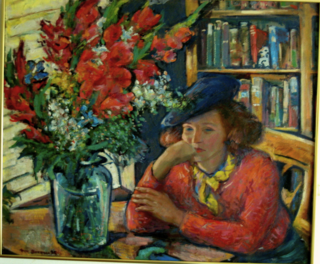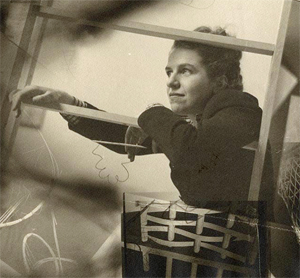Related Research Articles

Op art, short for optical art, is a style of visual art that uses optical illusions.

Victor Vasarely, was a Hungarian-French artist, who is widely accepted as a "grandfather" and leader of the Op art movement.

Victor Brauner was a Romanian painter and sculptor of the surrealist movement.
Leon Polk Smith (1906–1996) was an American painter. His geometrically oriented abstract paintings were influenced by Piet Mondrian and he is a follow er of the Hard-edge school. His best-known paintings constitute maximally reduced forms, characterized by just two colors on a canvas meeting in a sharply delineated edge, often on an unframed canvas of unusual shape. His work is represented in many museums in the United States, Europe, and South America. Thanks to a generous bequest from the artist, the Brooklyn Museum has 27 of his paintings on permanent display.
Walter Darby Bannard was an American abstract painter and professor of art and art history at the University of Miami
Edward Avedisian was an American abstract painter who came into prominence during the 1960s. His work was initially associated with Color field painting and in the late 1960s with Lyrical Abstraction.
Alfred Julio Jensen was an abstract painter. His paintings are often characterized by grids of brightly colored triangles, circles or squares, painted in thick impasto. Conveying a complex web of ideas, often incorporating calligraphy or numerical systems, they are frequently referred to as "concrete" abstract art. After his death in 1981, the Guggenheim organized a major retrospective of his work, having held his solo exhibition there in 1961.

The American artist collaborative, Anonima group, was founded in Cleveland, Ohio, in 1960 by Ernst Benkert, Francis Hewitt and Ed Mieczkowski. Propelled by their rejection of the cult of the ego and automatic style of the abstract expressionists, the artists worked collaboratively on grid-based, spatially fluctuating drawings and paintings that were precise investigations of the scientific phenomena and psychology of optical perception. The work was accompanied by writings: proposals, projects and manifestos - socialist in nature - which the artists considered essential to the experience and understanding of their work. Their drawings, paintings and writings, which had much in common with the positions of artist Ad Reinhardt, and with the Russian constructivists, were included in the 1965 Responsive Eye exhibit at the Museum of Modern Art. Along with other artists in the exhibit, Anonima's work was incorrectly relegated to what came to be the highly commercialized and publicized category of op art. A recent reconsideration and recontextualization of op art, the expansive 2006 Optic Nerve exhibit at the Columbus Museum of Art, places the Anonima as the sole American collaborative group, along with the European Zero Group, Gruppo N, GRAV and others, who were examining new optical information at that time.

James Francis Gill is an American artist and one of the protagonists of the Pop art movement. In 1962, the Museum of Modern Art included his Marilyn Tryptych into its permanent collection. At the peak of his career, Gill retired. He returned to the art scene around 30 years later.

Getulio Alviani was an Italian painter based in Milan. He is considered to be an important International Optical - kinetic artist.

Aaron Berkman was an American Social Realist and Modern painter who was involved in the Federal Art Project, which was the visual arts arm of the Great Depression-era New Deal. Although born in Hartford, Connecticut in 1900, he later moved to New York City in 1929.
Pat Adams, NA is an American modernist painter and mixed-media artist.
The Terrain Gallery, or the Terrain, is an art gallery and educational center at 141 Greene Street in SoHo, Manhattan, New York City. It was founded in 1955 with a philosophic basis: the ideas of Aesthetic Realism and the Siegel Theory of Opposites, developed by American poet and educator Eli Siegel. Its motto is a statement by Siegel: "In reality opposites are one; art shows this."
Ralph Tracy "Ted" Coe was a notable art collector and scholar, best known for developing modern appreciation of Native American art. "He was kind of the beginning player, enormously significant in the growth of appreciation of Native American art in the 20th century", noted a curator from the Metropolitan Museum of Art.

Sue Fuller was an American sculptor, draughtsman, author, teacher and printmaker who created three-dimensional works with thread. She was a student of Hans Hofmann in 1934, Stanley Hayter in 1943, and Josef Albers in 1944. She was awarded the Alumni Merit Award by Carnegie Mellon University in 1974, and the Lifetime Achievement Award by Women's Caucus for Art in 1986. A passionate devotee of modern art, Sue Fuller began her career as a printmaker then used some of the techniques she experimented with to develop an original form of sculpture.
Cecile Gray Bazelon is an American painter living in New York City. Bazelon is best known for her perspectives of unpeopled New York cityscapes, and her depictions of interior spaces framed in geometric patterns.

Jeffrey Steele (1931–2021) was an abstract painter. In Paris (1959) he encountered the work of artists working in the mode of geometric abstraction, such as Victor Vasarely (1906–97), Max Bill (1908–94) and Josef Albers (1888–1976), and adopted a lifelong abstract approach. For eight years he worked purely in black and white and was identified with the Op-art movement. He incorporated other colours into his work in the 1970s.

Kurt Ferdinand Roesch (1905–1984) was a German born American painter.
Oli Sihvonen (1921–1991) was a post-World War II American artist known for hard-edge abstract paintings. Sihvonen's style was greatly influenced by Josef Albers who taught him color theory and Bauhaus aesthetics at Black Mountain College in the 1940s. Sihvonen was also influenced by Russian Constructivism, Piet Mondrian, and Pierre Matisse. His work has been linked to Abstract Expressionism, Minimalism, Hard-Edge and Op-Art.

Winslow George Anderson was a noted artist, painter, ceramicist and glass designer from Plymouth, Massachusetts. A graduate of Alfred University's School of Ceramics, Anderson was a leading glass designer for the Blenko Glass Company of West Virginia (1946-1953) and Design Director for Lenox China and Crystal, located in Trenton, New Jersey (1953-1979). He was the recipient of numerous accolades during his lifetime, including Museum of Modern Art Good Design Awards. His works have been exhibited and collected by museums across the United States, including the Baltimore Museum of Art, Cooper Hewitt, Smithsonian Design Museum, Metropolitan Museum of Art, Museum of Modern Art, and the Solomon R. Guggenheim Museum.
References
- Falk, Peter Hastings (Editor). Who Was Who in American Art 1564-1975 3 Vols, 1999.
- Bowker R R. Who's Who in American Art 1993-94, 20th Edition, 1993.
- Jaques Cattell Press. Who's Who in American Art, 1986.
- Barr, Alfred H. Painting and Sculpture in the Museum of Modern Art, 1977.
- Jaques Cattell Press. Who's Who in American Art 12th Edition, 1977.
- Seitz, William C. The Responsive Eye, 1965.
